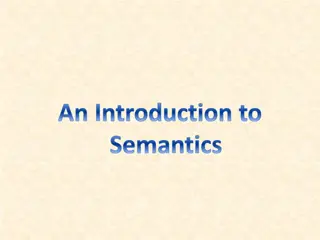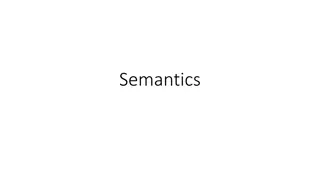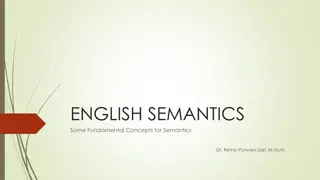Understanding Semantics: The Study of Meaning in Linguistics
Semantics is the scientific study of meaning in language, delving into questions about definitions, ideas, objects, relations between meanings, and how meanings interact with syntactic rules. Exploring the vagueness of the term "meaning," semanticists explore sense, reference, denotation, and connotation of linguistic expressions to grasp the depth and richness of language. Dive into the fascinating realm of semantics to unravel the intricate web of meanings in human communication.
Download Presentation

Please find below an Image/Link to download the presentation.
The content on the website is provided AS IS for your information and personal use only. It may not be sold, licensed, or shared on other websites without obtaining consent from the author. Download presentation by click this link. If you encounter any issues during the download, it is possible that the publisher has removed the file from their server.
E N D
Presentation Transcript
What is Semantics ANY UNDERSTAND OF LANGUAGE MUST TRY TO DESCRIBE AND EXPLAIN THE WAYS IN WHICH LINGUISTIC EXPRESSIONS MEANING. ATTEMPT THE TO NATURE HAVE
Semantics is The scientific study of meaning. It is different from Lexicography.
Semantics is one of the richest and most fascinating parts of linguistics.
Among the kinds of questions semanticists ask are the following : What are meanings definitions? ideas in our heads? sets of objects in the world? Can all meanings be precisely defined?
What explains relations between meanings, like synonymy, antonymy (oppositeness), and so on? What is the connection between what a word means, and the contexts in which it is used? How do the meanings of words interact with syntactic rules and languages express the same meanings? How do meanings change? principles? Do all
What is meaning? Meaning , however, is a very vague term. In ordinary English, the word meaning is used to refer to such different things as the idea or intention lying behind a piece of language, as in (1), the thing referred to by a piece of language (2), and the translations of words between languages (3).
(1) I dont quite understand what you re getting at by saying meat is murder : do you mean that everyone should be a vegetarian? (2) I meant the second street on the left, not the first one. (3) Seiketsu means clean in Japanese.
an linguistic distinguish different types of meaning. important initial task is of to semantics between these
Sense/reference/denotation/connotation The sense of a lexeme may be defined as the general meaning underlying the word. approximation, we can describe this as what we usually think of as contained in a dictionary entry for the word in question. or the As concept a first
. The notion of sense can be made more explicit through category of referent. A word s referent is the object which it stands for on a specific occasion of use. contrast with the
The queen has fallen off the table If I am talking about a rowdy evening at Buckingham Palace in 2009, the referent of the word queen is Her Majesty, Elizabeth II, and the referent of the word table is a particular piece of English royal furniture. But if I am talking not about Elizabeth II but about Queen Margret he of Denmark, the words queen and table have different referents: not Elizabeth II and the English piece of furniture, but Margrethe and the Danish one. On each of the occasions (28) is uttered, there is one and only one referent of each word
Obviously, words like queen and table stand for many different people and objects in the world: they have, in other words, many different referents. The referents change each time we talk about a different queen, or a different table. The entire class of objects, etc., to which an expression correctly refers is called the expression s denotation.
Words have the referents they have by virtue of a certain act on the part of the speaker, which we will call the act of reference. We will use this term to describe what the speaker does in applying a particular language particular referent in the world. expression to a
In uttering Dr Schreber suffered his first illness in the autumn of 1884. the speaker makes reference to a certain person, Dr Schreber, to a certain disease, his first illness, and to a certain time, the autumn of 1884.
An expressions denotation is the class of possible objects, situations, etc. to which the word can refer. The term reference, by contrast, has two uses: as the name of the act by which a speaker refers to a referent; as a synonym of referent, i.e. as the term for the object(s) to which an expression refers on a particular instance of use
Connotation meaning which do not affect a word s sense, reference or denotation, but which have to do with secondary factors such as its emotional force, its level of formality, its character as a euphemism, etc. names those aspects of
Police officer and cop, for example, have very different connotations, but similar denotations, as do the following pairs: brat and child toilet and rest room country and town
How do the meanings of words combine to create the meanings of sentences? What is the difference between literal and non-literal meaning? How do meanings relate to the minds of language users, and to the things words refer to?























